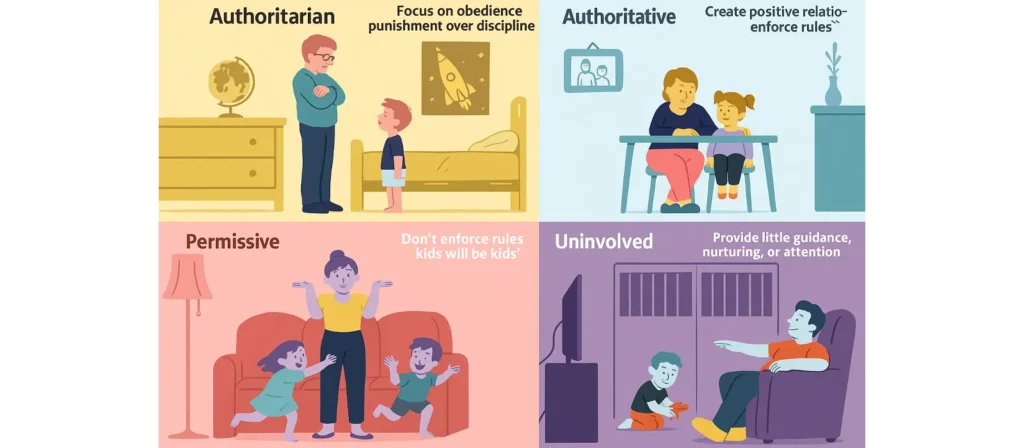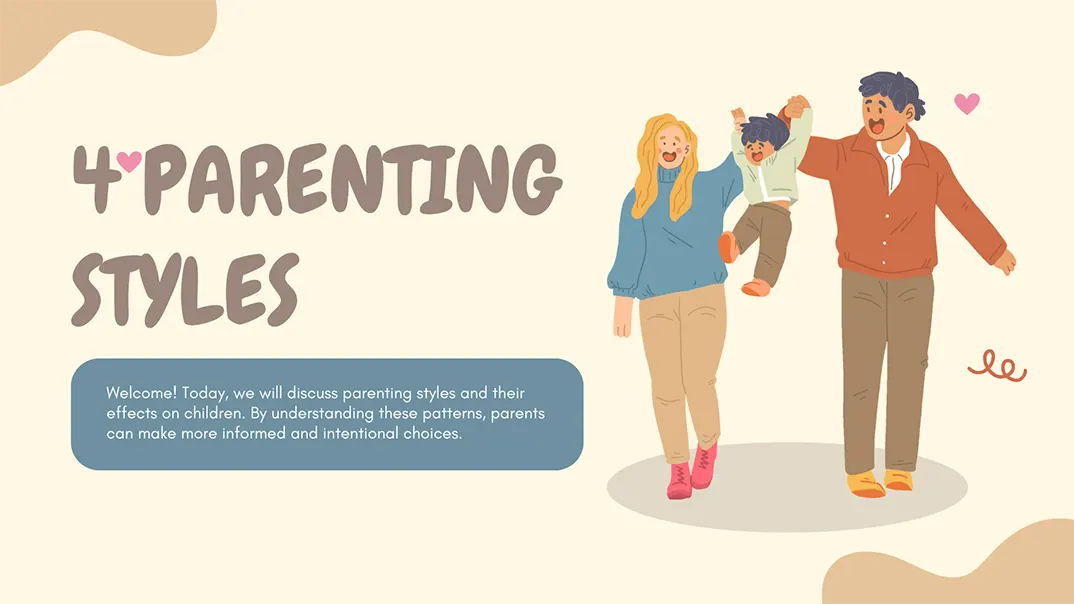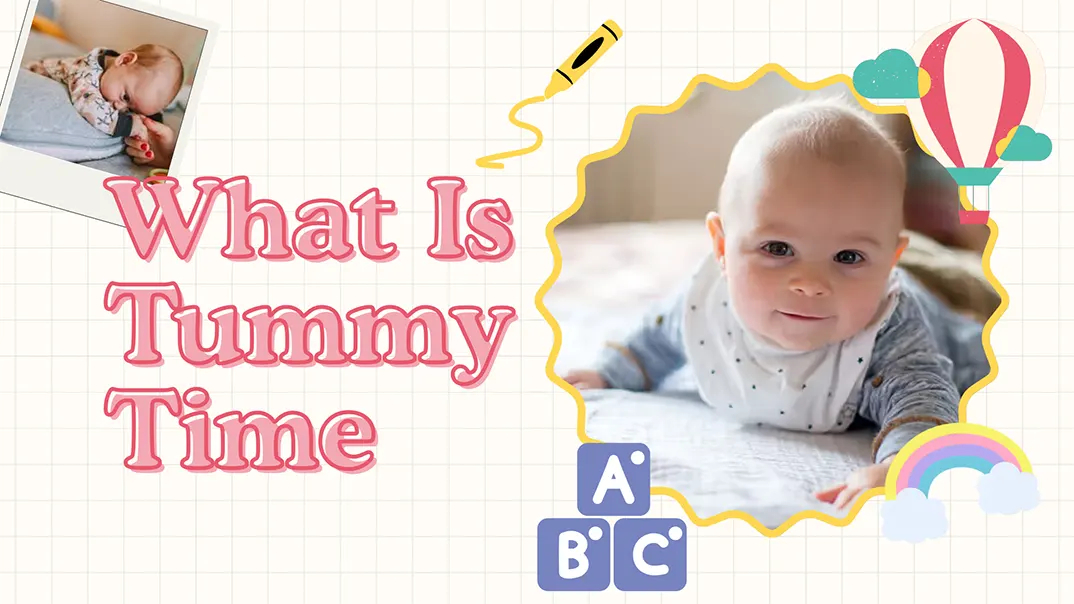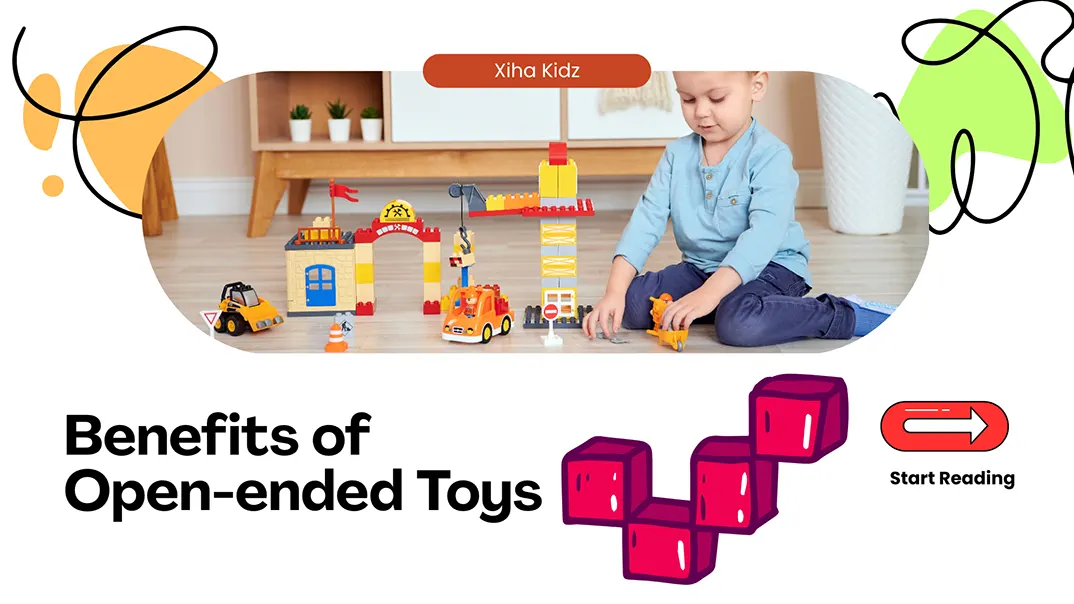Parenting is not an exact science, but it is far from a total mystery. Every child enters the world with a unique temperament and genetic makeup. It is the environment we provide that shapes how they grow and develop. Love, boundaries, attention, and discipline are the everyday choices that build the foundation of a child’s emotional and behavioral life.
This is where the 4 parenting styles come into focus. Developmental psychologist Dr. Diana Baumrind introduced the concept of four distinct parenting styles: authoritative, authoritarian, permissive, and uninvolved. These styles represent different levels of warmth, structure, and expectations, each with its own impact on a child’s development.
No parent fits neatly into a single category, and no two children respond the same way. The goal is not to parent perfectly, but to parent consciously. By becoming aware of your approach and its effects, you can make thoughtful adjustments that encourage confidence, resilience, and emotional health in your child.
What Are the 4 Types of Parenting Styles?
The concept of parenting styles was first introduced by developmental psychologist Dr. Diana Baumrind in the 1960s. Her research identified distinct patterns in how parents interact with their children and how these patterns influence a child’s development. Over time, these observations evolved into the widely recognized model of four parenting styles: authoritative, authoritarian, permissive, and uninvolved.
Each parenting style is defined by two key dimensions: responsiveness (the degree of warmth, emotional support, and communication) and demandingness (the level of expectations, rules, and discipline). The way parents balance these two dimensions results in very different outcomes for children.
1. Authoritarian Parenting Style
The authoritarian parenting style is one of the 4 parenting styles identified by developmental psychologists. It is characterized by high demandingness but low responsiveness. Parents who adopt this style tend to value obedience, discipline, and order above emotional connection or open communication.
Authoritarian parents often enforce strict rules without providing explanations, and they expect those rules to be followed without question. Emotional warmth is limited, and children’s opinions are rarely considered. This approach relies heavily on punishment to control behavior rather than teaching or guiding the child toward self-regulation.
Authoritarian parents often view themselves as authority figures whose rules are not to be challenged. They may use phrases like “Because I said so” to end conversations, rather than offering explanations. This parenting style is rooted in control and often shaped by cultural, generational, or personal values around discipline and respect.
Key Characteristics of Authoritarian Parenting:
- High control with low warmth and flexibility
- Emphasis on obedience and discipline
- Limited emotional responsiveness or nurturing
- One-way communication from parent to child
- Harsh or punitive discipline strategies
Effects on Children:
Children raised under authoritarian parenting may become obedient and disciplined in the short term, but they often do so out of fear rather than understanding. Over time, this can lead to increased anxiety, low self-esteem, and difficulties with decision-making. These children may struggle with independence, have poor social skills, and may either rebel against authority or become overly dependent on it.

2. Permissive Parenting Style
A permissive parenting style is marked by warmth, acceptance, and a low level of control or discipline. Parents who follow this style often prioritize their child’s happiness over enforcing rules, resulting in an environment where few boundaries exist. They tend to act more like friends than authority figures, providing support but rarely requiring accountability.
Key Characteristics of Permissive Parenting:
- High warmth with low expectations and control
- Few rules or inconsistent discipline
- Avoidance of confrontation or strict enforcement
- Encouragement of self-expression without limits
- Strong emotional bonding, but minimal behavioral guidance
Effects on Children:
Children raised in permissive households often enjoy a close emotional bond with their parents, but they may struggle with impulse control, emotional regulation, and respect for rules. Without clear boundaries, they can develop poor study habits, difficulty managing frustration, and a lack of responsibility. Over time, these challenges may affect academic performance and peer relationships.

3. Uninvolved Parenting Style
Uninvolved parenting, sometimes called neglectful parenting, is characterized by a lack of responsiveness, guidance, and involvement in a child’s life. Parents using this style provide basic needs such as food and shelter but offer little emotional support, communication, or structure. This absence of engagement often stems from stress, lack of knowledge, or personal struggles that leave parents unable to invest in consistent caregiving.
Key Characteristics of Uninvolved Parenting:
- Low responsiveness and low demandingness
- Minimal supervision or emotional involvement
- Lack of clear expectations or consistent rules
- Poor communication with the child
- Often emotionally distant or unavailable
Effects on Children:
Children raised by uninvolved parents often feel neglected, unsupported, and emotionally isolated. Without adequate guidance or connection, they may struggle with self-esteem, academic performance, and forming healthy relationships. These children are at a higher risk of developing behavioral problems, anxiety, depression, and difficulty trusting others.
Among the four parenting styles, the uninvolved approach is considered the most harmful to a child’s development. Without the foundation of love, structure, and support, children may not develop the emotional and social skills needed to thrive in school, relationships, and life in general.

4. Authoritative Parenting Style
Among the 4 parenting styles, authoritative parenting is often regarded as the most balanced and effective. This approach blends high expectations with warmth, support, and open communication. Authoritative parents set clear rules and boundaries, but they also listen to their children’s needs and explain the reasoning behind their expectations.
These parents value independence and encourage their children to express opinions and make decisions within safe limits. Discipline is consistent but not harsh, and it focuses on guidance rather than punishment. Children are treated with respect, and in turn, they are expected to behave responsibly.
Key Characteristics of Authoritative Parenting:
- High responsiveness and high demandingness
- Clear rules and consistent boundaries
- Warm, nurturing, and respectful communication
- Encouragement of independence and problem-solving
- Use of positive discipline and constructive feedback
Effects on Children:
Children raised by authoritative parents tend to develop strong emotional regulation skills and a positive self-image. They are often self-disciplined, socially competent, and academically successful. Because they grow up in an environment that combines structure with emotional support, these children are more likely to form healthy relationships, manage stress effectively, and show resilience in the face of challenges.
Authoritative parenting promotes mutual respect and trust between parent and child. It creates a home environment where children feel both safe and empowered, which lays a solid foundation for long-term development and well-being.

قم بتحويل فصلك الدراسي باستخدام حلول الأثاث المخصصة
Which Parenting Style Is Most Encouraged?
Among the 4 parenting styles, authoritative parenting is the most widely encouraged by child development experts, educators, and psychologists. This style is associated with the healthiest long-term outcomes for children across emotional, behavioral, social, and academic domains.

Authoritative parenting strikes a balance between high expectations and emotional warmth. It fosters independence while providing structure, encourages open communication while maintaining clear rules, and promotes discipline through guidance rather than fear. This approach helps children build self-confidence, emotional intelligence, and decision-making skills—traits that support success well beyond childhood.
Research consistently shows that children raised in authoritative households are more likely to:
- Succeed academically
- Develop strong emotional regulation skills
- Form healthy peer and adult relationships
- Show resilience in the face of stress or change
However, it’s important to recognize that parenting is not one-size-fits-all. Cultural values, family dynamics, and individual child temperaments all play a role in shaping what works best in each household. While the authoritative style provides a strong foundation, flexibility and self-reflection are key. The goal is not to follow a rigid formula, but to make intentional choices that support your child’s unique needs with both love and structure.
How to Change Your Parenting Style?
Recognizing your current approach within the four parenting styles framework is a powerful first step toward positive change. Whether you identify as an authoritarian, permissive, or uninvolved parent or even fluctuate between styles, know that transformation is possible. Parenting is a skill, not a fixed trait, and like any skill, it can be refined with self-awareness, patience, and consistent effort.

1. Reflect on Your Current Parenting Style
Begin by observing your daily interactions with your child. Notice how you set rules, respond to misbehavior, and show affection. Ask yourself whether your approach encourages independence, discipline, or emotional connection. Honest reflection helps you see where your style may not be serving your child’s best interests.
2. Identify the Impact on Your Child
Pay attention to your child’s responses—such as levels of confidence, responsibility, and emotional control. If your child struggles with boundaries, self-esteem, or communication, it may signal that adjustments in your parenting approach are needed.
3. Set Realistic and Specific Goals
Decide on small changes you can implement right away. For instance, if you are often permissive, commit to setting one consistent household rule. If you lean toward authoritarian, make space each day for open conversations where your child feels heard.
4. Learn and Apply New Strategies
Explore parenting resources such as books, workshops, or professional guidance. Techniques like positive discipline, active listening, and creating predictable routines help move your parenting toward a healthier balance of warmth and structure.
5. Practice Consistency and Patience
Children thrive when they know what to expect. Apply your new strategies regularly, but also be patient with yourself and your child. Change takes time, and it’s normal to make mistakes along the way.
6. Seek Support When Needed
Consider joining parenting groups, talking with educators, or seeking advice from family counselors. Supportive networks can provide encouragement, practical tips, and reassurance during the adjustment process.
قم بتحويل فصلك الدراسي باستخدام حلول الأثاث المخصصة
Limitations of Parenting Style
Although the four parenting styles offer a useful framework, they are not a complete picture of real-life parenting. Each style has its strengths, but also limitations that must be considered in a broader context. Below are key areas where the model may fall short:
- Parenting Styles Often Overlap in Real Life
In practice, most parents do not fit perfectly into just one category. A parent may be authoritative in most situations, but permissive when feeling exhausted or stressed. Others might shift styles depending on the child’s behavior or the environment. This flexibility means that labeling a parent as one type may oversimplify their actual approach. - Cultural and Socioeconomic Differences Matter
The four parenting styles were originally developed through research in Western, middle-class families. In different cultures, parenting norms can look very different. For example, what is considered “authoritarian” in one culture may be viewed as respectful and caring in another. As a result, the framework may not fully apply across global or multicultural settings. - The Model Focuses Mainly on the Parent
While the four parenting styles are based on parent behaviors, they do not always account for the unique traits of the child. Children have different temperaments, learning needs, and emotional responses. What works for one child may not work for another, even with the same parenting approach. - External Influences Are Overlooked
Parenting is only one part of a child’s development. Teachers, peers, media, extended family, and community environments also play major roles. The model assumes that the parent-child relationship is the primary influence, but in reality, children are shaped by many outside factors that are not captured in this framework. - It Does Not Account for Change Over Time
Parenting styles can evolve as children grow. A parent’s approach to a toddler may differ greatly from how they interact with a teenager. Life circumstances—such as divorce, job loss, or illness—can also affect parenting behaviors. The static nature of the four-category model doesn’t reflect the dynamic, changing reality of most families.
خاتمة
Now that you have a clearer understanding of the four parenting styles and how they influence child development, take time to reflect on your own approach. Consider how you typically interact with your child. Are there moments where more structure, patience, or support might help your child grow?
Parenting is not something fixed. It evolves through awareness, daily choices, and a willingness to improve. You do not need to make dramatic changes all at once. Starting with one or two thoughtful adjustments, such as setting clearer boundaries or listening more attentively, can lead to meaningful progress over time.
اكتشف مجموعتنا الكاملة من المنتجات
احصل على إمكانية الوصول إلى كتالوجنا الشامل الذي يحتوي على أثاث ومعدات لعب عالية الجودة لرياض الأطفال والمدارس.








